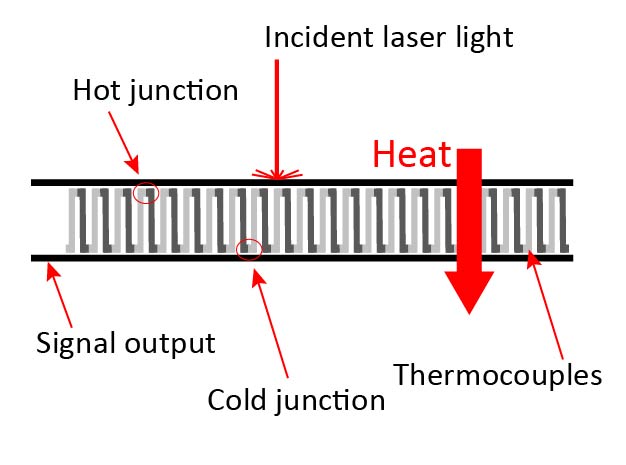What is a Thermopile?
A thermopile is an electronic device that converts thermal energy into electrical energy. It is composed of several thermocouples connected usually in series or, less commonly, in parallel. Such a device works on the principle of the thermoelectric effect, i.e., generating a voltage when its dissimilar metals (thermocouples) are exposed to a temperature difference.
Thermopile laser sensors are used for measuring laser power from a few µW to several W. The incoming radiation of the laser is converted into heat energy at the surface. This heat input produces a temperature gradient across the sensor. Making use of the thermoelectric effect a voltage is generated by this temperature gradient. Since the voltage is directly proportional to the incoming radiation, it can be directly related to the irradiation power.
Unlike photodiodes, thermopile sensors can be used for a broad spectrum of wavelengths ranging from UV to Infrared. Further, photodiodes are reverse biased and saturate for optical powers above a certain value (typically in mW), making thermopile sensors suitable for high power measurements.
How Does a Thermopile Work?
a thermopile laser sensor consists of several thermocouples connected in series with one junction type (hot junction at temperature T1) being exposed to an absorption area and the other junction type (cold junction at temperature T2) being exposed to a heat sink. When a laser beam hits the surface of a thermopile sensor, the incident radiation is absorbed within the coating layer and transformed into heat. This heat then induces a temperature gradient across the sensor given as

where t is the thickness of the sensor.
Due to the thermoelectric effect, the temperature difference causes an electrical voltage to build up within each thermocouple. This output voltage is directly proportional to the power of the incoming radiation. Since a large number of thermopiles are typically connected in series, voltages of several µV to V are reached.
In general, a thermopile sensor consists of three elements: an absorber, the sensor element and a cooling body to dissipate the incoming heat.
Application of Thermopile
Thermopile laser sensors find their use mainly where sensitivity to a wide spectral range is needed or where high laser powers need to be measured. Thermopile sensors are integrated into laser systems and laser sources and are used for sporadic as well as continuous monitoring of laser power, e.g. in feedback control loops.
Some of the applications are:
Ultrafast laser measurement
Short-pulsed lasers which are used in spectroscopy and optical communication can be measured using thermopile sensors since they possess high thresholds for laser induced damages, especially when equipped with a volume absorber.

Position detector
An arrangement of several thermally coupled thermopile sensors similar to a quadrant photodiode design can be used to detect beam position as well as beam power. This is useful for beam alignment purposes or for processes where a correct beam position is crucial for high production yield.
Industrial systems
Manufacturing processes require precision and reproducibility. For laser materials processing the monitoring of laser power is beneficial as it can avoid scrap production and yield high quality products. There are various ways of integrating a power measurement. Beam losses further down the beam path, caused e.g. by a deterioration of optics, are not mapped in this type of arrangement. As an alternative, detectors can be used for sporadic measurements at the laser system output. Usually, the full beam is measured in this case.
Power meters
For sporadic measurements outside the laser system (e.g. during maintenance) a separate measuring unit is beneficial. For such a power meter, the sensor element is usually integrated into a metal housing for mechanical and thermal stability. The signal is recorded and processed in a read-out unit which displays the measured laser power.
